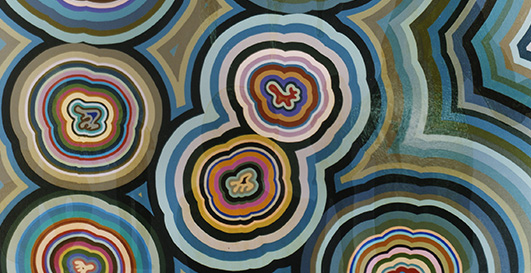
Oliveras

Domus referencial is the title chosen by Carolina Antoniadis for her anthological exhibition. This is so because the house or home (domus in Latin, hence, domestic) is the conceptual core of several stages of her work.
Already in her early paintings, homely scenes in which playing spaces prevailed appeared as the main reference. An omnipresent eye was able to perceive the house from different angles. It was warm and full, with joyous wallpapers making each room different from the other. In these rooms, carpets, blankets, curtains, cretonne tapestry sofas and printed fabric tablecloths piled up.
A Subjectivism in action Without leaving aside her initial interest for space, in her later stages Antoniadis practices playing with time or her way of playing with time, since it is now more than ever that her personal interpretation of the past is seen to prevail. Hegel was not mistaken when – in the first half of the XIX Century – he announced an extreme subjectivism in art. An excess which characterized what he called the “romantic” period. It is precisely what artists like Antoniadis put into their work: an extended subjectivism with no boundary, no closing of parts. A subjectivism of the author that serves as trigger – gives “wings” – to the equally subjective reading by the spectator. Antoniadis looks at the past and tries to produce “an essay on coincidences, fate, conscious and unconscious esthetic relationships within a family, my own one”, says she. She will discover similarities between her work and Grandfather Demetrio’s landscapes – expressed in paintings such as Luchas Intestinas (“Domestic Fights”) (1998). Also, with pictures taken by her parents, Leonor and Miguel and, more recently, by her brother Leonardo (a renowned representative of contemporary photography). Besides, her interest for design reflects the refinement of her grandmother and that of her mother, who drew illustrations for costume magazines.
De-constructing-oneself It can be said that Antoniadis’ work is deconstructive since it shows aspects of its genesis. Derrida had stated that – in a philosophical sense – “to deconstruct” (opposite to destroy) is to disclose marks, footprints, traces, influences of a productive process. Inasmuch as it is a “genealogical growth”, stated the philosopher, it is an infinite task since, as footprints are discovered, others appear in a never-ending chain. Consequently, discovering one’s own origin (and that of an artistic work) is not an easy task. It is made harder by memory, which, while extracting fragments of the past – thus making them visible -, also superimposes data, getting them mixed. There are also unconscious drives that hide what has been lived and that Antoniadis’ always generous imagination materializes in a profusion of geometric forms of concentric undulating lines and loud colors. Like autonomous self-sufficient organic excrescences, these abstract forms alternate and “compete” with the family figures. They are not mere “quotations” (of op art, for example) but rather images of (surprisingly beautiful) degenerative cells standing in the way of other motifs and turning the surface into a lively and powerful battlefield. Thus, the continuity of an autobiographical narration centered in characters and objects of the childhood world like the furniture in the dollhouse or the teddy bear of Yo y mi peluche (“Me and my plush”) (2005) is broken. We cannot fail to point out that those proliferating “cells” indicate the importance of Antoniadis’ collagist mentality. Linked to its constructive sense, collagism allows her to fill in the space and overcome an unwished for horror vacui. Thus, in Vacío Extremado (“Extreme Vacuum”) (2004), the bodies of the small characters appear totally submerged and “swallowed up” by an overelaborate space.
Neo-baroque Discontinuities Spatial discontinuity is a consequence of Antoniadis’ collagist mentality. Therefore, her constructions near neo-baroque overabundance and the “craziness of seeing” that characterizes it. We find it in works such as Ropa Interior (“Underclothes”) (1994), where what is normally not seen (the inside of the body) becomes reversible and visible, though it could also camouflage as the dress’ pattern. The neo-baroque “craziness of seeing” can be already noticed in early works of the end of the eighties. Different rooms could be seen at the same time on a same plane: a living room, a bedroom, a kitchen, a bathroom. Seeing the totality goes together with the – necessary – fragmentation that, in Antoniadis, leads to a fractal kind of beauty, characteristic of our zapping contemporary culture. “You will never seem to be able to put it together” seems to be the basic instruction. Fulfilling it becomes impossible as the spectators’ look wonders amidst a proliferation of figurative (furniture, pictures, dresses, cars, human figures) and abstract (weft, geometric patterns) symbols. Frontality in the representation of figures is another of Antoniadis’ work’s characteristic feature. Plane, without thickness, they seem to tell us that what is true is only found in the appearance, in the surface and that if we try to fathom deeper, we will only find new surfaces. This is the (profound) meaning of the artist’s images. Not coincidentally garments, and design in general, are so important in her work. From an Art History standpoint we can find in Antoniadis’ work not only its connection to the neo-baroque but also with the decorative and planist beauty of the nabis. There exists a coincidence between her aestheticism and that of Paul Éli Ranson, renowned painter as well as textile designer. The artist’s sinuous lines are very close to oriental taste, particularly to Japanese engravings and to Art Nouveau extensions.
Cessation of the Corporeal Experience While developing her work, Antoniadis gradually abandons the anonymity of figures. She no longer reproduces schematic models, like the illustrations of the costume magazines drawn by her mother, nor serialized icons (feminine or masculine), such as those found in La Elegida (“The Chosen One”) (1997), Destino Circular (“Circular Fate”) (1998) or Target (2002). Her figures will reach a stronger connection with what is “real”, as they are based in photographic projections of “real” beings. However,– on account of the mentioned planism – none becomes quite corporeal and almost loses this quality completely in works such as Modo potencial (“Conditional Tense”), being transfigured into shadows or semi-abstract energies. In this way, Antoniadis’ “real presences” are shown as indicating absences. Faces and frames of mind disappear under patterns and lines obsessively intercepting them, as in Felicidad utópica (“Utopian Happiness”) (2004), Presente imperfecto (“Present Continuous”) (2005), Elegancia (“Elegance”) or Pudor (“Decency”). Invaded by neighboring elements, the fragmented body expresses the impossibility of having a complete experience of it. According to Dewey, in order for this experience to exist, “consummation and not cessation” must exist. “Such experience is a whole and bears in itself its own individualizing and self-sufficing quality. This is not what we find in Antoniadis’ figures. Everything tends to a suspension and not a final termination. The suspension of the experience of the body – plane, fragmented and cut out in space under the seductive appearance of the dress – has the effect of neutralizing the difference between what is pictorial and design or decoration. Thus, the unrepeatable quality – and supposed seriousness – of what is human and the serial quality – and fascination – of what is decorative become one. In short, Psichisism and decorativism become interchangeable.
Pictorial Hedonism Since it is the subject matter of her own work, Antoniadis cannot avoid placing the act of painting at the center of pleasure. Though there is enigma in her visual narrations, they never flow into melancholy or dramatism since at all times she composes on a hedonist key, emphasizing the pleasure of doing. This pleasure will not always be tranquil for the spectator. It is not the relaxed pleasure of one who rests in the beautiful form. On the contrary, it is the pleasure of those who feel the challenge of participating in a poiesis that completes implicit meanings, even being aware that these have the specific feature of resisting their closure. On account of this semantic impossibility, each of Antoniadis’ images is a floating sign that takes us – from an autobiographical standpoint and further - to a disenchanted world, with no (fixed) attributes. To a world that hopes for beauty, even though apparent or fractal.
